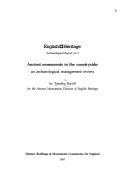Much of England's rich archaeological heritage lies in the countryside. Many monuments, such as barrows, hillforts, and Roman villas, are familiar features of the landscape, while other sites lie buried or only partly visible. These remains are the result of the impact on the landscape of the countless generations of people who have lived, worked and died within it. The cumulative effect is the landscape we know today, in which the historical dimension is an integral component of the valued whole and an important part of what most people in England are increasingly concerned to see protected and conserved.
The archaeological heritage, however, is a finite and fragile resource, and much of it has been lost in the last two decades as a result of increasing pressures on farming, industry, and commerce to maximise the return on investment in the land. The conservation of what remains, therefore, needs to be given urgent consideration.
This report has three main goals. First, it aims to present the background to the recognition, investigation, and management of the archaeological resource. Second, it attempts to review what is known of the resource, the threats currently posed to it, and the ways in which it can be exploited and conserved. Finally, it looks towards the development and promotion of a secure future for ancient monuments in the countryside.
- ISBN10 1850741670
- ISBN13 9781850741671
- Publish Date November 1987
- Publish Status Out of Print
- Out of Print 13 May 1996
- Publish Country GB
- Imprint English Heritage
- Format Paperback
- Pages 196
- Language English
